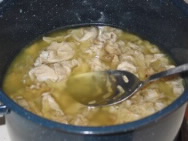EMBARGOED RELEASE | November 13, 2010
Cilantro ingredient can remove foul odor of “chitlins”
WASHINGTON, Nov. 13, 2010 — With chitlins about to make their annual appearance on Thanksgiving, Christmas, and New Year’s Day menus, scientists have good news for millions of people who love that delicacy of down-home southern cooking, but hate the smell. They are reporting the first identification of an ingredient in cilantro that quashes the notoriously foul odor of chitlins — a smell known to drive people from the house when chitlins are cooking. Their report appears in ACS’ Journal of Agricultural and Food Chemistry.
Yasuyoshi Hayata and colleagues note that chitlins — hog large intestines — are infamous for their foul smell, which is reminiscent of the waste material that once filled the intestine. However, many people enjoy the taste of the southern delicacy. When boiled or fried, chitlins are most popular in the United States during the winter holidays, from Thanksgiving to New Year’s Day. However, hog large intestine also is a year-round staple in the cuisines of the Caribbean, Latin America, and Asia.
Media Contact
Michael Bernstein
202-872-6042
m_bernstein@acs.org
Michael Woods
202-872-6293
m_woods@acs.org
Hayata’s group knew that cooks long have used fresh cilantro, an herb also known as coriander or Chinese parsley, to mask the unpleasant smell of certain foods, as well as add flavor. They previously showed that cilantro could help to remove the fecal or sewage-like odor from chitlins. In the new research, they set out to discover the identity of the deodorizing chemical compounds in cilantro.
The scientists treated samples of hog large intestine with cilantro extracts of different concentrations. A panel of human sniffers identified the concentrations that were most effective in reducing the odor. Using high-tech instruments, the scientists then isolated the main deodorizing ingredients in the most effective extracts. The scientists identified several cilantro ingredients that appeared to suppress the foul odor of chitlins. One of the substances with the tongue-twisting name of (E,E)-2,4-Undecadienal had a flowery fragrance that seemed to completely erase the odor. That substance worked at concentrations as low as 10 parts per billion — an equivalent to about 10 drops of substance in an Olympic-size swimming pool.
Full text article:
“Identification of (E, E)-2,4-Undecadienal from Coriander (Coriandrum sativum L.) as a Highly Effective Deodorant Compound against the Offensive Odor of Porcine Large Intestine”
Journal of Agricultural and Food Chemistry
###



